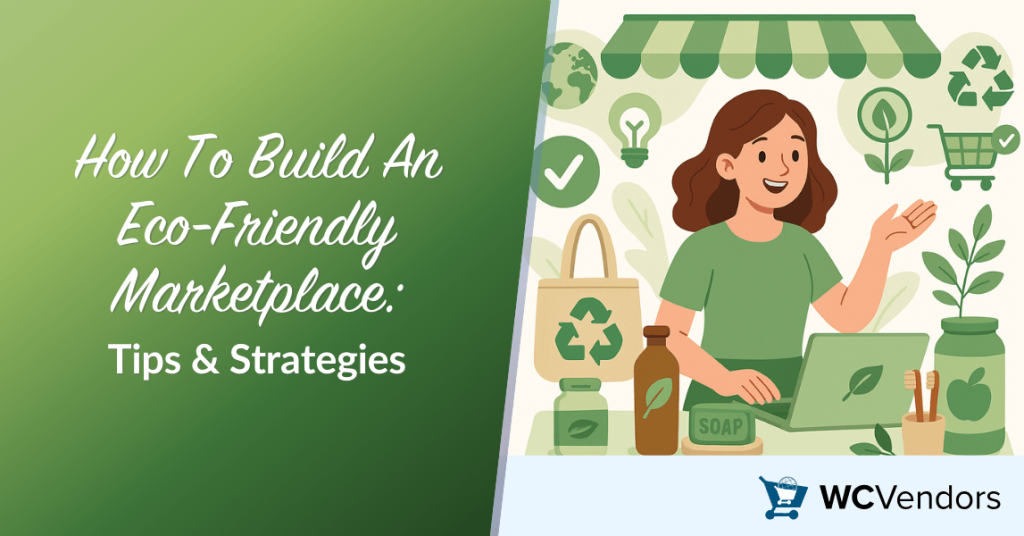
More people are shopping with the planet in mind, and they’re turning to an eco-friendly marketplace that reflect those values. It connects environmentally conscious shoppers with brands that align with sustainable and ethical values.
Sustainability in e-commerce matters because it influences how products are made, packaged, and delivered. As such, a well-structured eco-friendly marketplace gives both buyers and sellers the chance to reduce their impact and support long-term environmental goals.
In this article, we’ll walk through the key steps to building your own eco-friendly marketplace, covering everything from choosing the right products to structuring your storefront and marketing it to the right audience.
Why Build A Sustainable Marketplace?
A growing number of shoppers are actively seeking alternatives to wasteful consumption. That’s where sustainable marketplaces come in.
An eco-friendly marketplace is a type of sustainable marketplace that focuses on minimizing environmental impact through conscious product selection, ethical sourcing, and responsible business practices.
As interest in sustainable and ethical practices grows, online marketplaces play a bigger role in offering verified, lower-impact alternatives. Building a sustainable marketplace aligns your business with these long-term shifts and gives you a chance to make a meaningful impact through commerce.
Step 1: Choose What To Sell

Once you’ve identified your core products, the next step is choosing the platform that helps you manage and promote them effectively.
Here are some popular eco-friendly marketplace product categories and examples you can feature:
- Personal care: Bamboo toothbrushes, compostable floss, shampoo bars
- Kitchen and home: Beeswax wraps, refillable cleaning sprays, silicone food bags
- Fashion: Clothing made from organic cotton, recycled fabrics, or plant-based leather
- Office and school: Recycled notebooks, refillable pens, eco-friendly laptop sleeves
- Grocery and pantry: Bulk goods with minimal packaging, fair trade coffee, reusable produce bags
Look for suppliers offering fair trade goods and work with ethical brands known for transparency. You can also feature niche categories such as sustainable fashion, upcycled accessories, or greener products and services aimed at both consumers and small businesses.
Pro Tip: Start with 1–2 product categories that are easy to verify for sustainability, like personal care or office supplies. This reduces complexity and helps you build trust early.
Once you know what you’re selling and where it’s coming from, the next step is choosing a platform that supports those values and gives you full control over your eco-friendly marketplace.
Step 2: Choose A Platform
Choosing the right platform is essential to building a store that can help you with your sustainability goals and gives you the flexibility to grow. Your tech stack should allow for customization, transparency, and long-term scalability.
| Platform | Best For | Pros | Limitations |
|---|---|---|---|
| WooCommerce | Custom eco-friendly stores | Full ownership, customizable, open-source | Requires hosting and setup effort |
| Shopify | Quick setup with basic green apps | Easy to launch, app ecosystem includes sustainability features | Less customizable, limited marketplace support |
| BigCommerce | Fast-growing stores with API use | Scalable performance, supports sustainability apps and databases | Multi-vendor requires third-party integrations |
WooCommerce
WooCommerce is an open-source eCommerce platform that’s ideal for entrepreneurs who want full ownership of their store.
It offers full control over your product catalog, checkout process, and data policies. WooCommerce is a great choice if you’re starting small but want the option to scale in the future.
If your goal is to build a multi-vendor store, you’ll want a platform that allows you to expand gradually. WooCommerce, paired with a WordPress marketplace plugin like WC Vendors, gives you that flexibility (see Step 6).
Shopify
Shopify is a hosted platform that offers a quicker setup experience and several sustainability-related apps. However, it has more limitations when it comes to customizing marketplace functionality and long-term flexibility.
BigCommerce
BigCommerce provides strong performance for fast-growing online stores. It integrates with various databases and supports third-party apps. However, multi-vendor functionality often requires third-party services.
To process payments sustainably and transparently, use Stripe for marketplaces, which supports:
- Secure payment splitting between vendors and admin
- Transparent transaction history for compliance and reporting
- Region-compliant KYC and tax processes that align with local regulatory requirements
Try this: Pair WooCommerce with WC Vendors and Stripe for Marketplaces to manage vendors and payments ethically and transparently.
Once your platform is selected and configured, the next step is to define sustainability guidelines that your vendors will follow.
Step 3: Set Sustainability Guidelines For Vendors
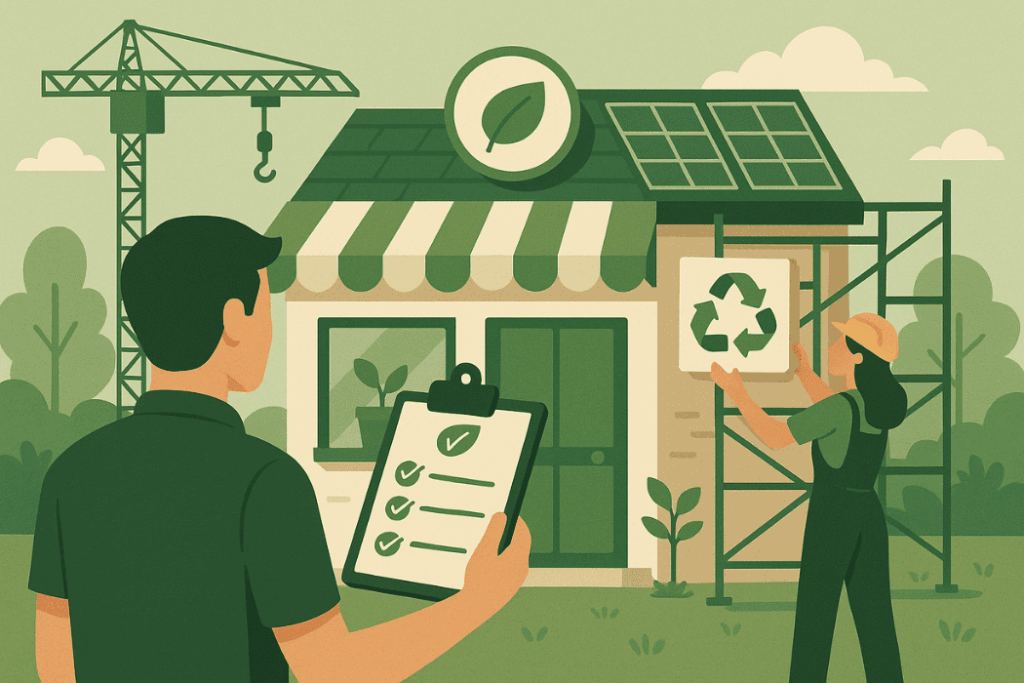
Clear guidelines are important, but your storefront must also reflect these values in its design and structure.
Tips for defining vendor standards:
- Accept only fair trade or recycled materials. For example, vendors could be required to source raw materials like cotton, paper, or metals from certified fair trade suppliers or use inputs with recycled content. You can verify this by requesting third-party certifications or audit reports during onboarding.
- Require disclosure of sourcing and production practices. Ask vendors to complete a sustainability profile that outlines where their materials come from, how their products are manufactured, and whether they follow any labor or environmental standards. This can be integrated into vendor onboarding forms using WC Vendors’ custom registration fields.
- Use badges for greener products and certified ethical brands. Display visual indicators like “Recycled Material,” “Plastic-Free,” or “Fair Trade Certified” on product pages. You can do this by using WooCommerce product attributes or plugins that allow conditional display based on tags or certifications.
With WordPress marketplace plugins like WC Vendors, you can onboard vendors using a checklist, and configure role-specific permissions to keep your standards consistent.
Try this: Offer tiered visibility (e.g., featured listings or badges) for vendors who meet higher sustainability benchmarks.
Once your vendor requirements are clearly defined, the next step is building a storefront that reflects your eco-friendly marketplace’s sustainability values.
Step 4: Build And Configure Your Storefront
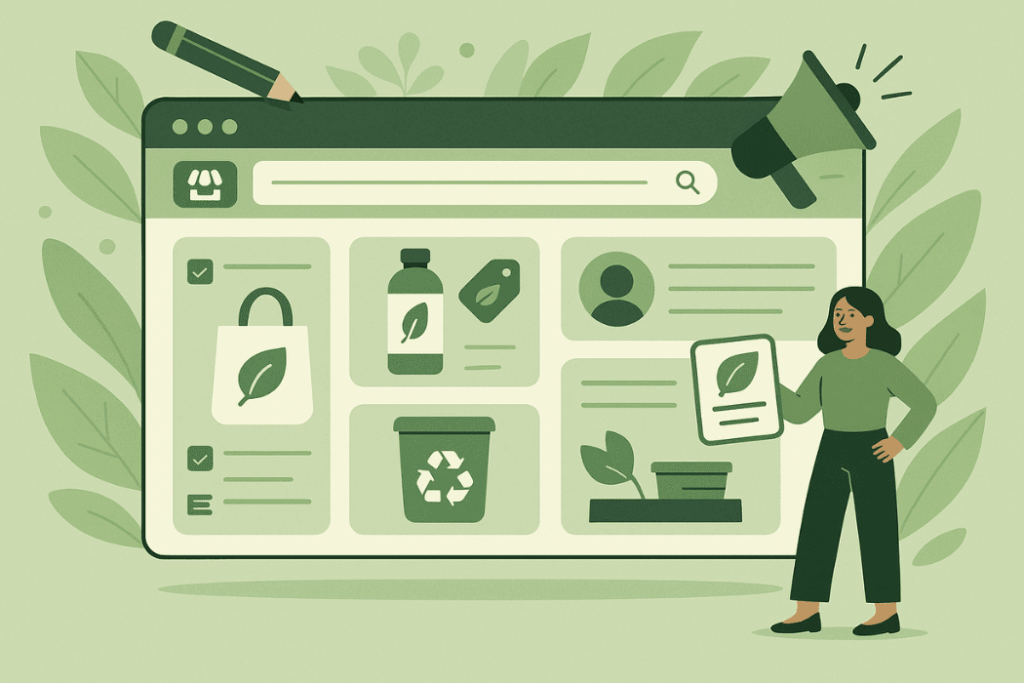
Once your store is up and running, it’s time to bring in traffic and educate your audience through strategic marketing.
Codica shares a case where they helped create a digital marketplace focused on eco products. The platform added vendor profiles, sustainability badges, and impact metrics, which increased product engagement by 32% within the first three months.
You can:
- Tag sustainable products to help buyers filter listings
- Add vendor profile pages showcasing eco-friendly credentials
- Use your design and copy to promote sustainable shopping habits
These changes improve trust and reinforce your values across the platform.
Bonus Tip: Add product filters for “plastic-free,” “fair trade,” or “recycled” so buyers can shop based on their values.
With a storefront designed to reflect your commitment to sustainability, your next step is to attract conscious consumers through purposeful marketing.
Step 5: Promote Sustainable Shopping Through Marketing
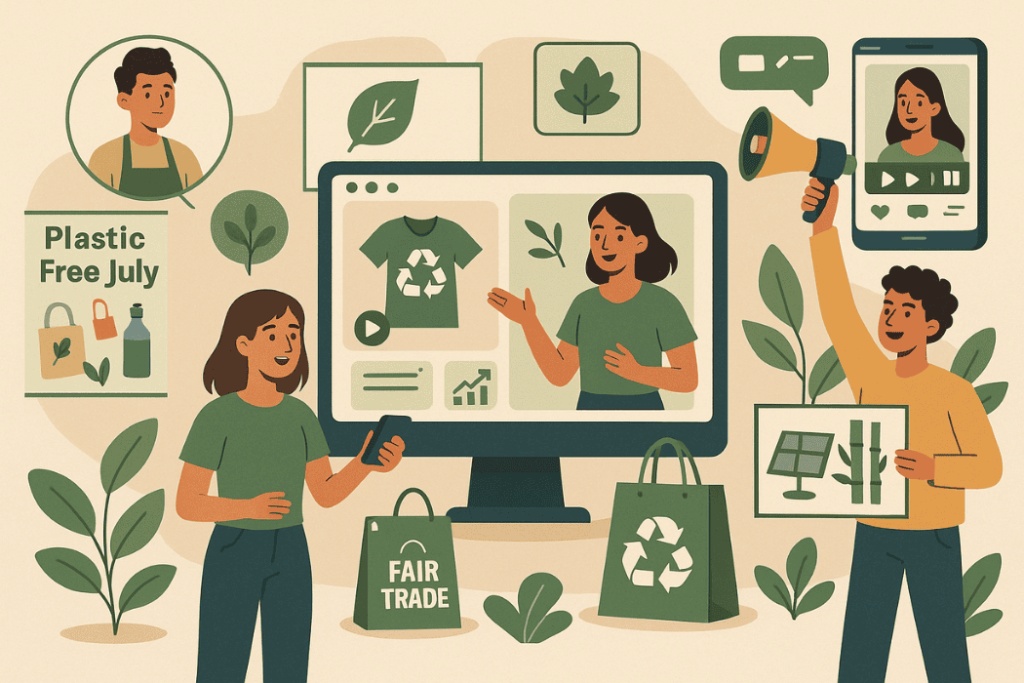
Looking at real-world eco-friendly marketplace examples can give you even more ideas for structuring your platform for impact.
Start by highlighting how your marketplace supports ethical shopping through every transaction. Focus on SEO-friendly topics such as sustainable shopping habits, greener products and services, and fair trade sourcing.
Marketing strategies include:
- Featuring stories of ethical brands in your marketplace
- Creating product guides (e.g., “Top Greener Products and Services for the Home”)
- Running campaigns around sustainable shopping events like Plastic-Free July
- Using infographics to show your marketplace’s sustainability impact
- Sharing video content and vendor interviews on social media
Use keywords like sustainable shopping, products and services, ethical brands, and digital marketplace in your content to reach environmentally conscious shoppers. Also, create SEO-optimized product descriptions that explain how each item supports sustainability.
Highlight materials, certifications, packaging choices, and usage tips. These details help your listings appear in search results and give shoppers more confidence. You can use WooCommerce AI tools like StoreAgent to streamline this process and keep your messaging consistent.
Try this: Highlight seasonal campaigns (e.g., Earth Day, Plastic-Free July) to create urgency and relevance around your products and vendors.
With your marketing strategy in place, it’s helpful to see how other marketplaces have applied these principles successfully.
Step 6: Learn From Marketplace Examples
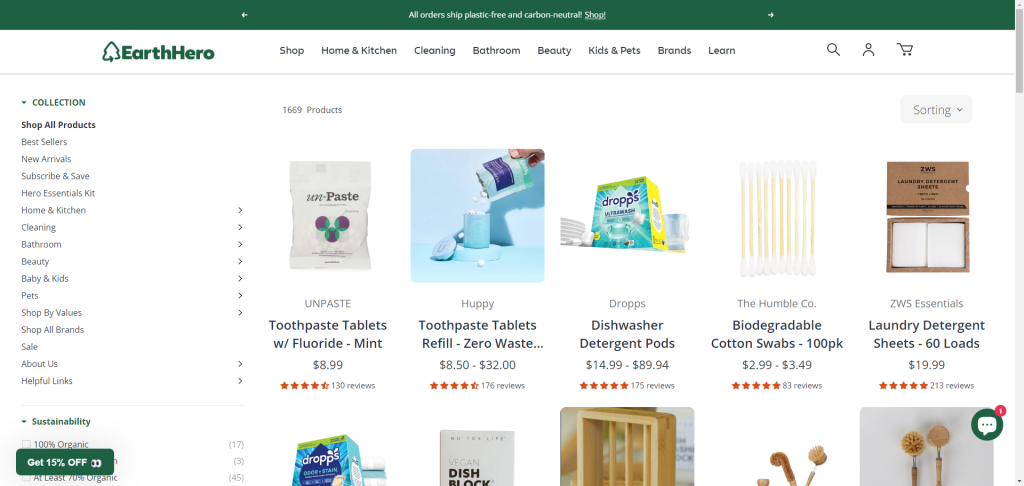
Studying successful eco-friendly marketplaces can help clarify what works in practice—and why. These platforms provide inspiration for your own strategy, from product sourcing to vendor requirements.
- ThredUP is a large-scale sustainable fashion marketplace that specializes in secondhand clothing. It uses a circular model to reduce waste and lets customers track their environmental impact with every purchase.
- Etsy supports independent sellers and highlights sustainable products through dedicated categories and search filters. It encourages the use of eco-conscious packaging and offers guides for sellers interested in sustainability.
- EarthHero is a curated sustainable online marketplace that evaluates every product against a strict list of sustainability criteria. It focuses on transparency, low-waste shipping, and education to help consumers make better choices.
Each of these platforms shows how clear messaging, seller accountability, and thoughtful UX design contribute to marketplace trust and performance. Use these examples to guide your own design, vendor policies, and communication strategy.
Pro Tip: Study what successful marketplaces do well—like EarthHero’s filters or ThredUP’s impact tracking—and adapt these ideas to your niche.
Scaling to a Multi-Vendor Marketplace

Once your foundation is in place, you may decide to open your platform to additional vendors who align with your sustainability standards. WC Vendors makes this possible.
As a WooCommerce multi-vendor marketplace plugin, WC Vendors equips you with vendor-specific tools and workflow controls.
- Vendor transparency: Editable profiles and dedicated storefronts help customers make informed choices.
- Approval workflows: Control who sells and what gets listed in your marketplace.
- Eco-labeling and tagging: Use custom taxonomies or attributes to highlight sustainable products.
This structure allows you to scale your operations without compromising your values or the buyer experience.
Conclusion
An eco-friendly marketplace allows you to shape buyer habits, reduce waste, and offer products and services that align with conscious consumption. It’s a long-term strategy that supports both environmental values and business growth.
To recap, here are the steps to build your eco-friendly marketplace:
- Choose What to Sell
- Choose a Platform
- Set Sustainability Guidelines for Vendors
- Build and Configure Your Storefront
- Promote Sustainable Shopping Through Marketing
- Learn From Marketplace Examples
If you’re serious about launching a marketplace that aligns with sustainable values, now is the best time to start. WC Vendors and WooCommerce give you the tools to do it your way—flexibly, affordably, and with full control.
Want to build and scale your eco-friendly marketplace? Explore WC Vendors’ plans and features today.
Frequently Asked Questions
What makes a product eco-friendly?
An eco-friendly product is made with minimal environmental impact, often using sustainable materials, ethical labor, and low-waste packaging.
Can I run an eco-friendly store without stocking physical products?
Yes, you can offer digital products or services that promote sustainable living, such as e-books, workshops, or memberships.
Do I need special certifications to call my marketplace eco-friendly?
No, but it’s best to clearly communicate your sustainability criteria and vet vendors carefully to maintain trust with customers.
What are some low-cost ways to make my marketplace more eco-conscious?
Start with eco-friendly packaging, clear product descriptions, and vendor education on sustainable practices.
